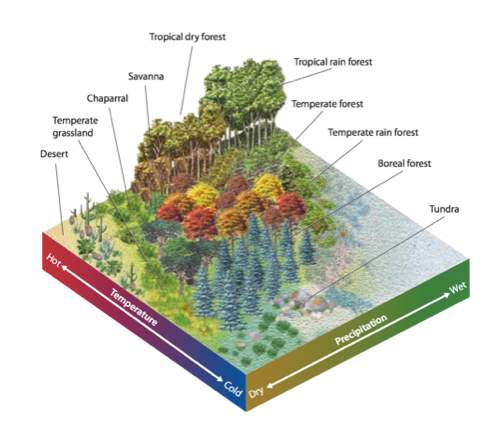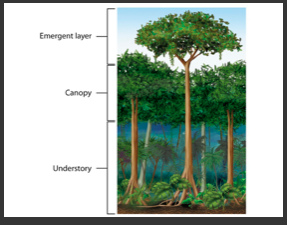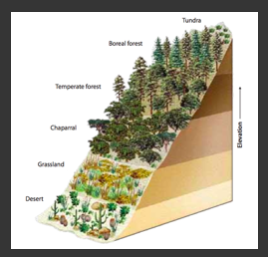Frog book: biomes



elephants and biodiversity
carrying capacity-new term
biome: climate and plant/animal life
errors in ch.6-where?
Fig 6.3

NPP: biomass after respiration
(rate which primary producers convert energy to biomass)
tropical rain forest-canopy (layers)--------
poor soil nutrient levels (all in trees)

shallow roots, big leaves, lots of rain
pitcher plants-eat animals
epiphytes-grow on other plants (e.g. orchids)
air roots
specialized animals
tropical dry forest——
deciduous forest: warm, but variable rain (e.g. monsoon)
autumn leaves-loss to protect plant, changes in photosynthesis
waxy leaves (e.g. pine needles) if over winter plants
estivation: hibernation
migration: birds (why birds and not other animals?)
savanna——
very dry, few trees, seasonal grasses, fires
porous soils (like Kona), often coffee locations (s. america)
waxy leaves, deep roots
desert——
under 25 cm (250 mm) of water per year (10 inches)
dry dry dry, so dramatic temp variations (opposite of ocean biomes)
few plants, low nutrient levels in soil
nocturnal animals (e.g. rats, snakes)
succulents: store water (e.g. cacti)
large, shallow roots, also taproots (160 ft. deep)
temperate rain forest——
not too warm, not too cold, just right
rainy, warm, mossy, foresty (e.g. washington, oregon, BC)
coniferous-have pine cones, conifers: oily needles (don’t freeze)
lumber
temperate forest——
eastern US: oak etc. seasonal loss of leaves
hibernating animals
temperate (mild) grassland——
prairie, steppe (russia)
moderate rain, but not enough for trees. grass only.
grass grows from below, so can be eaten by cattle and still live
roots capture moisture, hold soil together (kikuyu grass)
chaparral——
California, mediterranean (middle of the earth, contrast with chinese translation of the word “china”: middle earth kingdom)
dry, seasonal rain, drought (like now)
Boreal (north) forest———
taiga
acidic soils (from conifers/pine needles as competition)
very cold
conifer shape sheds snow, preserves branches (christmas trees)
when ground freezes, no water for roots, all water stored as sap in trees (oily compound, very sticky, makes retsina in Greece)
tundra——
russia, alaska, canada
very cold-study the climatograph (-220 °C!) right….
permafrost-permanently frozen ground, so only shallow roots
polar ice—
not really a biome, but stuff lives there (aquatic mammals, fish, very small rocks, churches, mud, but no ducks)
Notothenioids-antifreeze fish
blubbery mammals
mountains—
another non-biome, but look at this!

how cool is that?
aquatic ecosystems—
salinity, depth, standing or flowing water
salt water = 30-50 ppt (parts per thousand)
ppt, ppm, ppb
fresh water = 0.5 ppt
in between 0.5-30 ppt = brackish (anchialine ponds in Kona)
study the fishies in the pictures
DEPTH!!!!
determines amount of light, tf. photosynthesis
photic zone=light
aphotic=no light
benthic=really no light, never, ever ever. don’t even think about it.
aquatic mammals must surface for air
fishies don’t-gills
DO dissolved oxygen (very important) depends on plants (so depth) and temp (cooler water can hold more O2)
warm water has low O2 generally.
best place to fish: cool water after a waterfall (why?)
flowing water: rivers
standing water: ponds
lakes can become inland seas
littoral=shore, limentic=away from shore benthic=botttom
wetlands:
marshes, swamps, bogs and fens
marshes marshes marshes!-tall grasses
swamps-some trees
bogs-acidic, poor decomposition, floating stuff
fens-spring underneath, less acidic, better nutrients
bogs decay slowly-ancient cheese story, peat moss
rivers-oxbow lake and meander
source, tributary (continuity concept), mouth (delta)
slope exponential as distance from source
deposition rates (rapids vs. plains)
silt carrying capacity, turbidity
estuaries-like deltas
tidal estuary: hudson river: deeper than the body it serves
oceans——
200 ft. of salt if all oceans evaporated
oceans were red (iron) then ppt out (iron range in WI, MI)
salinity, wind and temperature determine flow
upwelling (recall Peruvian fisherpersons)
also downwelling
photic zones-
intertidal zone-makes sense, between tides
neritic zone-close to shore, less than 200 ft. deep (not in Hawaii, we have no continental shelf-boo hoo)
open ocean (pelagic) zone
kelp forests-e.g. california coast
coral reefs-away from fresh water, coastal, photic
open ocean-scary stuff
/groups/apenvironmentalscience/search/index.rss?tag=hotlist/groups/apenvironmentalscience/search/?tag=hotWhat’s HotHotListHot!?tag=hot6/groups/apenvironmentalscience/sidebar/HotListadminadmin2020-08-19 15:43:59+00:002020-08-19 15:43:59updated30adminadmin2011-09-08 21:36:21+00:002011-09-08 21:36:21updated29adminadmin2011-08-24 23:20:40+00:002011-08-24 23:20:40updated28adminadmin2011-08-24 22:42:36+00:002011-08-24 22:42:36updated27adminadmin2011-08-22 02:41:09+00:002011-08-22 02:41:09updated26adminadmin2011-08-22 02:40:02+00:002011-08-22 02:40:02updated25adminadmin2011-08-21 20:39:11+00:002011-08-21 20:39:11updated24adminadmin2011-08-21 20:30:42+00:002011-08-21 20:30:42updated23adminadmin2011-08-21 20:30:13+00:002011-08-21 20:30:13updated22adminadmin2011-08-21 20:25:48+00:002011-08-21 20:25:48updated21adminadmin2011-08-21 20:25:18+00:002011-08-21 20:25:18updated20adminadmin2011-08-21 00:22:12+00:002011-08-21 00:22:12updated19adminadmin2011-08-21 00:18:56+00:002011-08-21 00:18:56updated18adminadmin2011-08-21 00:15:43+00:002011-08-21 00:15:43updated17adminadmin2011-08-21 00:12:37+00:002011-08-21 00:12:37updated16adminadmin2011-08-21 00:12:02+00:002011-08-21 00:12:02updated15adminadmin2011-08-20 23:59:41+00:002011-08-20 23:59:41updated14Added tag - hotadminadmin2011-08-20 23:59:38+00:002011-08-20 23:59:38addTag13Added tag - conservationadminadmin2011-08-20 23:59:32+00:002011-08-20 23:59:32addTag12Added tag - critical thinkingadminadmin2011-08-20 23:59:19+00:002011-08-20 23:59:19addTag11Added tag - ch1adminadmin2011-08-20 23:59:08+00:002011-08-20 23:59:08addTag10Added tag - sustainabilityadminadmin2011-08-20 23:59:05+00:002011-08-20 23:59:05addTag9adminadmin2011-08-20 20:47:39+00:002011-08-20 20:47:39updated8adminadmin2011-08-20 20:46:15+00:002011-08-20 20:46:15updated7adminadmin2011-08-20 20:43:07+00:002011-08-20 20:43:07updated6adminadmin2011-08-20 19:14:13+00:002011-08-20 19:14:13updated5adminadmin2011-08-20 19:11:26+00:002011-08-20 19:11:26updated4adminadmin2011-08-20 18:59:57+00:002011-08-20 18:59:57updated3adminadmin2011-08-20 18:56:59+00:002011-08-20 18:56:59updated2First createdadminadmin2010-11-07 01:41:28+00:002010-11-07 01:41:28created1wiki2020-08-19T15:43:59+00:00groups/apenvironmentalscience/wiki/welcomeFalseCh01 Overview/groups/apenvironmentalscience/wiki/welcome/Ch01_Overview.htmladmin30 updatesCh01 Overview
Welcome to our APES wiki. You should be able to do the following after logging in with your account:
To create a new page, click the ...Falseadmin2020-08-19T15:43:59+00:00adminadmin2013-02-05 02:24:03+00:002013-02-05 02:24:03updated4Added tag - hotadminadmin2013-02-05 02:24:02+00:002013-02-05 02:24:02addTag3adminadmin2013-02-05 02:05:35+00:002013-02-05 02:05:35updated2First createdadminadmin2013-02-05 02:03:35+00:002013-02-05 02:03:35created1wiki2013-02-05T02:24:03+00:00groups/apenvironmentalscience/wiki/394a8FalseEnergy notes/groups/apenvironmentalscience/wiki/394a8/Energy_notes.htmladmin4 updatesEnergy notes
Week of 2.4.13: energy wrap-up
e2 video: coal vs. nuclear in class
AP exams: FRQ
2002.1
2004.2
2006.1
2007.2
2008.1
...Falseadmin2013-02-05T02:24:03+00:00adminadmin2013-02-05 02:23:20+00:002013-02-05 02:23:20updated6Added tag - hotadminadmin2013-02-05 02:23:18+00:002013-02-05 02:23:18addTag5adminadmin2013-02-05 02:23:12+00:002013-02-05 02:23:12updated4adminadmin2013-02-05 02:21:48+00:002013-02-05 02:21:48updated3adminadmin2013-02-05 02:20:26+00:002013-02-05 02:20:26updated2First createdadminadmin2013-02-05 02:06:00+00:002013-02-05 02:06:00created1wiki2013-02-05T02:23:20+00:00groups/apenvironmentalscience/wiki/c360bFalseFeb-May plan/groups/apenvironmentalscience/wiki/c360b/FebMay_plan.htmladmin6 updatesFeb-May plan
1. conclusion of energy chapters (see previous wiki)
2. GCC AP questions FRQ:
2006.2
2005.3
2005.4
2007.3
...Falseadmin2013-02-05T02:23:20+00:00adminadmin2012-03-07 05:53:55+00:002012-03-07 05:53:55updated14adminadmin2012-03-07 05:43:38+00:002012-03-07 05:43:38updated13adminadmin2012-03-07 05:41:35+00:002012-03-07 05:41:35updated12adminadmin2012-03-07 05:38:57+00:002012-03-07 05:38:57updated11Added tag - hotadminadmin2012-03-07 05:38:55+00:002012-03-07 05:38:55addTag10adminadmin2012-03-07 05:36:47+00:002012-03-07 05:36:47updated9adminadmin2012-03-07 05:22:26+00:002012-03-07 05:22:26updated8adminadmin2012-03-07 05:20:01+00:002012-03-07 05:20:01updated7adminadmin2012-03-07 05:18:58+00:002012-03-07 05:18:58updated6adminadmin2012-03-07 04:58:55+00:002012-03-07 04:58:55updated5adminadmin2012-03-07 04:57:33+00:002012-03-07 04:57:33updated4adminadmin2012-03-07 04:56:53+00:002012-03-07 04:56:53updated3adminadmin2012-03-07 04:54:20+00:002012-03-07 04:54:20updated2First createdadminadmin2012-03-07 04:53:33+00:002012-03-07 04:53:33created1weblog2012-03-07T05:53:55+00:00groups/apenvironmentalscience/weblog/de030FalseGreen Apple/groups/apenvironmentalscience/weblog/de030/Green_Apple.htmladmin14 updatesGreen Apple
Team,
Please watch this video about NYC:
Trailer:
http://www.pbs.org/e2/episodes/101_the_green_apple_trailer.html
On the server:
http://physics.hpa...Falseadmin2012-03-07T05:53:55+00:00adminadmin2011-09-13 19:08:24+00:002011-09-13 19:08:24updated4Added tag - hotadminadmin2011-09-13 19:08:22+00:002011-09-13 19:08:22addTag3adminadmin2011-09-13 19:08:10+00:002011-09-13 19:08:10updated2First createdadminadmin2011-09-13 19:04:30+00:002011-09-13 19:04:30created1weblog2011-09-13T19:08:24+00:00groups/apenvironmentalscience/weblog/4ecddFalseQuestions for Wednesday, wiki adds/groups/apenvironmentalscience/weblog/4ecdd/Questions_for_Wednesday_wiki_adds.htmladmin4 updatesQuestions for Wednesday, wiki adds
Team,
I'd like to try something for class tomorrow: each of you to create a question from chapter 3, and email it to me by this evening (Tuesday). Pl...Falseadmin2011-09-13T19:08:24+00:00hot/groups/apenvironmentalscience/search/index.rss?sort=modifiedDate&kind=all&sortDirection=reverse&excludePages=wiki/welcomelist/groups/apenvironmentalscience/search/?sort=modifiedDate&kind=all&sortDirection=reverse&excludePages=wiki/welcomeRecent ChangesRecentChangesListUpdates?sort=modifiedDate&kind=all&sortDirection=reverse&excludePages=wiki/welcome0/groups/apenvironmentalscience/sidebar/RecentChangesListmodifiedDateallRecent ChangesRecentChangesListUpdateswiki/welcomeNo recent changes.reverse5searchlist/groups/apenvironmentalscience/calendar/Upcoming EventsUpcomingEventsListEvents1Getting events…
Comments